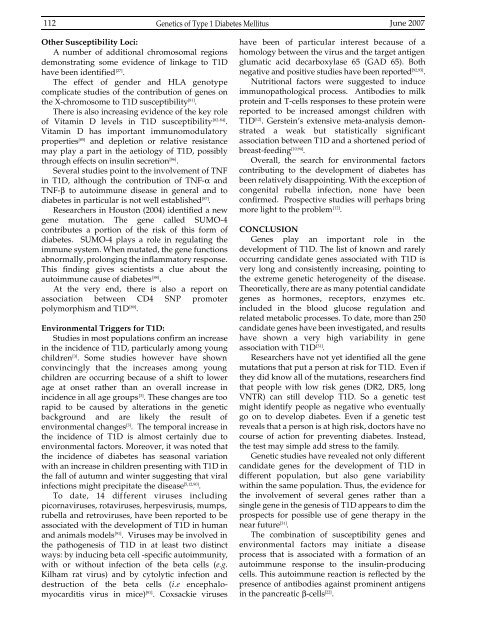Vol 39 # 2 June 2007 - Kma.org.kw
Vol 39 # 2 June 2007 - Kma.org.kw
Vol 39 # 2 June 2007 - Kma.org.kw
- No tags were found...
Create successful ePaper yourself
Turn your PDF publications into a flip-book with our unique Google optimized e-Paper software.
112Genetics of Type 1 Diabetes Mellitus <strong>June</strong> <strong>2007</strong>Other Susceptibility Loci:A number of additional chromosomal regionsdemonstrating some evidence of linkage to T1Dhave been identified [27] .The effect of gender and HLA g e n o t y p ecomplicate studies of the contribution of genes onthe X-chromosome to T1D susceptibility [81] .There is also increasing evidence of the key roleof Vitamin D levels in T1D susceptibility [ 82 - 84 ] .Vitamin D has important immunomodulatoryproperties [85] and depletion or relative resistancemay play a part in the aetiology of T1D, possiblythrough effects on insulin secretion [86] .Several studies point to the involvement of TNFin T1D, although the contribution of TNF-α andTNF-β to autoimmune disease in general and todiabetes in particular is not well established [87] .Researchers in Houston (2004) identified a newgene mutation. The gene called SUMO-4contributes a portion of the risk of this form ofdiabetes. SUMO-4 plays a role in regulating theimmune system. When mutated, the gene functionsabnormally, prolonging the inflammatory response.This finding gives scientists a clue about theautoimmune cause of diabetes [88] .At the very end, there is also a report onassociation between CD4 SNP p ro m o t e rpolymorphism and T1D [89] .Environmental Triggers for T1D:Studies in most populations confirm an increasein the incidence of T1D, particularly among youngc h i l d re n [ 3 ] . Some studies however have shownconvincingly that the increases among youngchildren are occurring because of a shift to lowerage at onset rather than an overall increase inincidence in all age groups [3] . These changes are toorapid to be caused by alterations in the geneticb a c k g round and are likely the result ofenvironmental changes [3] . The temporal increase inthe incidence of T1D is almost certainly due toenvironmental factors. Moreover, it was noted thatthe incidence of diabetes has seasonal variationwith an increase in children presenting with T1D inthe fall of autumn and winter suggesting that viralinfections might precipitate the disease [5,12,90] .To date, 14 diff e rent viruses includingpicornaviruses, rotaviruses, herpesvirusis, mumps,rubella and retroviruses, have been reported to beassociated with the development of T1D in humanand animals models [91] . Viruses may be involved inthe pathogenesis of T1D in at least two distinctways: by inducing beta cell -specific autoimmunity,with or without infection of the beta cells (e.g.Kilham rat virus) and by cytolytic infection andd e s t ruction of the beta cells (i . e e n c e p h a l o -m y o c a rditis virus in mice) [ 9 1 ] . Coxsackie viru s e shave been of particular interest because of ahomology between the virus and the target antigenglumatic acid decarboxylase 65 (GAD 65). Bothnegative and positive studies have been re p o r t e d [ 9 2 , 9 3 ] .Nutritional factors were suggested to induceimmunopathological process. Antibodies to milkprotein and T-cells responses to these protein werereported to be increased amongst children withT1D [12] . Gerstein’s extensive meta-analysis demonstrateda weak but statistically significantassociation between T1D and a shortened period ofbreast-feeding [10,94] .Overall, the search for environmental factorscontributing to the development of diabetes hasbeen relatively disappointing. With the exception ofcongenital rubella infection, none have beenconfirmed. Prospective studies will perhaps bringmore light to the problem [12] .CONCLUSIONGenes play an important role in thedevelopment of T1D. The list of known and rarelyoccurring candidate genes associated with T1D isvery long and consistently increasing, pointing tothe extreme genetic heterogeneity of the disease.Theoretically, there are as many potential candidategenes as hormones, receptors, enzymes etc.included in the blood glucose regulation andrelated metabolic processes. To date, more than 250candidate genes have been investigated, and resultshave shown a very high variability in geneassociation with T1D [31] .Researchers have not yet identified all the genemutations that put a person at risk for T1D. Even ifthey did know all of the mutations, researchers findthat people with low risk genes (DR2, DR5, longVNTR) can still develop T1D. So a genetic testmight identify people as negative who eventuallygo on to develop diabetes. Even if a genetic testreveals that a person is at high risk, doctors have nocourse of action for preventing diabetes. Instead,the test may simple add stress to the family.Genetic studies have revealed not only differentcandidate genes for the development of T1D ind i ff e rent population, but also gene variabilitywithin the same population. Thus, the evidence forthe involvement of several genes rather than asingle gene in the genesis of T1D appears to dim theprospects for possible use of gene therapy in thenear future [31] .The combination of susceptibility genes ande n v i ronmental factors may initiate a diseaseprocess that is associated with a formation of anautoimmune response to the insulin-pro d u c i n gcells. This autoimmune reaction is reflected by thepresence of antibodies against prominent antigensin the pancreatic β-cells [22] .
















